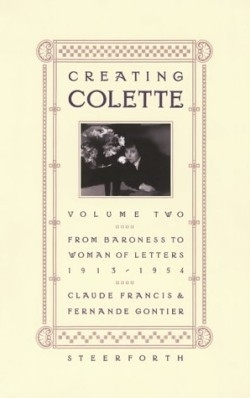Creating Colette Volume II
From Baroness to Woman of Letters 1912-1954
In the first volume of their stunning biography of the French author Colette (published November, 1998), Francis and Gontier not only showed the sensuality, talent and wide-ranging life of the ultimate libertine, but also her weaknesses, frailties and humanity. With remarkable research skills and novelistic prose, the authors delved into the childhood and young adulthood of Sidonie-Gabrielle Colette, who rose from the rural village of Saint-Saveur to notoriety among Paris’ elite set. Even among the tony and cynical Parisians, the young Colette caused a stir with her spicy writing and even spicier romantic life.
As a woman who constantly reinvented herself and lived jubilantly according to her pleasure, she loved and slept with whomever she wanted, from the troubled Henri Gauthier-Villars, who would become her first husband, to the cross-dressing Marquise de Belbeuf, who became the reason she left Henri. She was equally adept at dancing nude in lesbian salons as she was at penning novels and studying Schumann piano pieces, and the authors describe it all, complete with juicy details and telling anecdotes.
Since Colette’s life was far too full for one lone book, Francis and Gontier ended the first volume in 1913, as the fin-de-siecle partygirl hit forty years old. The second volume, as artfully written and delightfully insightful as the first, begins with the death of Colette’s sensualist mother, Sido, a woman who influenced her daughter far more than any of the writer/actress’ subsequent friends or lovers. With eloquence, the authors describe Sido’s desperate letters to Colette, asking her daughter to come home so that she could see her before she died. That Colette failed to grant her mother’s wish and instead immersed herself in passionate love affairs is less an act of malice than one of denial, but Sido’s death changed Colette, who finally resolved to settle down a little and dampen the more salacious aspects of her life.
Just months after Sido died, Colette married aspiring politician Henry de Jouvenel and became a baroness, then a mother herself. Although she was less ostentatious about her affairs, she continued to have them, even bedding her sixteen-year-old stepson, stating that “the perversity of gratifying an adolescent lover does not devastate a woman, quite to the contrary.” The stormy marriage ended in 1925 when her husband, after years of womanizing, fell in love with a Rumanian princess.
Grander than a soap opera, steamier than her own novels, Colette’s life continued in a fashion typical to her Auntie Mame point of view. At the time of her divorce, she had established herself as France’s leading woman of letters, having created Gigi, the Claudine novels and The Ripening Seed. Her work was blatantly autobiographical and expertly displayed the workings of the Parisian café society, complete with thinly disguised real life characters and barely concealed true events.
At fifty-two, after all her numerous affairs, Colette finally found and married the love of her life, Maurice Goudeket, a Jewish man sixteen years younger than she. During World War II, Goudeket was detained in a concentration camp and marked for deportation to Auschwitz. In a frenzy, Colette called upon her powerful friends, spending emotionally wrenching months trying to free him and although she ultimately succeeded, the effort caused her health to decline and in 1954, she died on Goudeket’s birthday. (In an ironic twist that Colette would have adored, he died twenty-three years later, on her birthday.) She was the first woman writer to be granted a state funeral, an event she probably would have regarded with indifference, since soon before her death she declared that she had watched the unfolding of life and found that experience amounts to nothing, that the world was new to her every morning and that death is only a commonplace defeat.
Colette’s work is still of some interest, but it’s her life that has the power to endlessly fascinate, especially in the richness of volumes like Creating Colette. Francis and Gontier do more than illuminate the humanity of an icon—they do honor to a woman who knew how to grasp all the passion, beauty and love that life has to offer.
Reviewed by
Elizabeth Millard
Disclosure: This article is not an endorsement, but a review. The publisher of this book provided free copies of the book to have their book reviewed by a professional reviewer. No fee was paid by the publisher for this review. Foreword Reviews only recommends books that we love. Foreword Magazine, Inc. is disclosing this in accordance with the Federal Trade Commission’s 16 CFR, Part 255.


